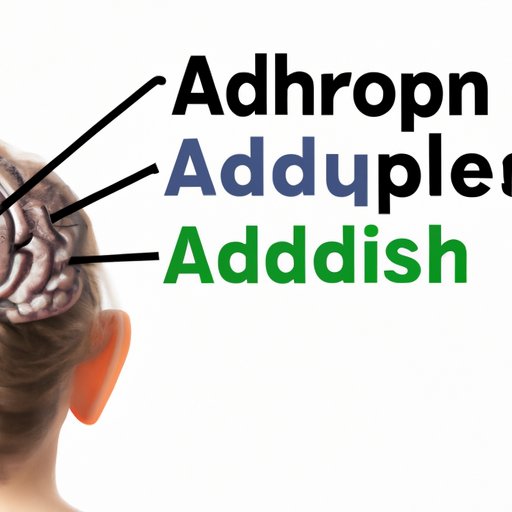I. Introduction
Attention-Deficit/Hyperactivity Disorder (ADHD) is commonly associated with children, but it is possible for individuals to develop the disorder in adulthood. ADHD affects approximately 4.4% of the adult population, but many remain undiagnosed or misdiagnosed. This article aims to explore whether a person can develop ADHD in adulthood, and how early recognition and proper treatment can greatly improve one’s quality of life.
II. Importance of Recognizing ADHD in Adulthood
ADHD is a neurodevelopmental disorder that can interfere with daily functions and relationships. Symptoms of ADHD in adults often manifest as forgetfulness, procrastination, impulsivity, disorganization, and difficulty concentrating. Recognizing these symptoms is essential in helping adults seek proper medical attention for their symptoms. Early diagnosis and treatment can significantly impact an individual’s success in both personal and professional life, as well as mental health and relationships.
III. Understanding Neurodevelopmental Disorders
The brain chemistry of individuals with ADHD is different from those without the disorder. The prefrontal cortex and striatum, responsible for regulating attention, emotions, and actions, develop differently in individuals with ADHD. This can result in difficulties with focus, memory, emotions, and impulsivity. Research has shown that the brain networks associated with ADHD in adults differ from those in children, signifying that ADHD may affect adults differently.
IV. Causes & Risk Factors of ADHD in Adulthood
The causes of ADHD in adulthood are not yet fully understood. Research suggests that genetic predisposition, environmental factors, and lifestyle choices contribute to the development of ADHD in adulthood. Studies have shown that genetics accounts for 70-80% of ADHD cases, while exposure to toxic substances like lead and tobacco smoke during pregnancy and childhood increases the risk. Other environmental factors like prenatal stress, brain injuries, and premature birth may also contribute to the disorder.
V. The Diagnosis Process for Adult ADHD
Diagnosing ADHD in adults involves assessing an individual’s current symptoms, medical history, and lifestyle. Diagnosis can be tricky since other conditions such as anxiety, depression, bipolar disorder, and sleep disorders can mimic ADHD symptoms, making accurate diagnosis critical to appropriate treatment. Doctors may conduct a physical examination, cognitive tests, and interview the patient and their family. The criteria for diagnosing ADHD include a persistent pattern of inattention or hyperactivity/impulsivity that interferes with normal functioning.
VI. Treatment Options for Adult ADHD
Treatments for ADHD in adults include medications aimed at addressing the neurological issues related to the disorder. The most common medications prescribed are central nervous system stimulants such as Ritalin, Adderall, and Vyvanse. Therapy, including cognitive-behavioral therapy and coaching, can also be useful in helping adults develop strategies and coping mechanisms to manage their symptoms. Lifestyle changes such as exercise, structured routines, and healthy eating habits can also be effective adjuncts to medication and therapy.
VII. Overcoming the Stigma of Adult ADHD
There are numerous myths and misconceptions surrounding ADHD, leading to a significant amount of stigma around the disorder. People with ADHD are often stigmatized as being lazy, unmotivated, and lacking self-control. It is important to acknowledge that ADHD is a genuine neurological disorder and that those living with it are often working twice as hard to function effectively. It’s also essential to reduce stigma so that individuals with ADHD can seek treatment without fear of being judged or misunderstood.
VIII. Living with Adult ADHD: Practical Tips & Coping Mechanisms
Living with ADHD can be challenging but developing practical coping mechanisms can go a long way in helping individuals manage their symptoms. Developing routines and lists can help with organization, while mindfulness techniques and exercise can improve focus and reduce impulsivity. Apps and gadgets can also help with daily life—consider using calendar apps, noise-cancelling headphones, and timers that can assist with time management and reducing distractions.
IX. Conclusion
Overall, ADHD is a complex but treatable neurological disorder that can develop in adulthood. Understanding the symptoms, causes, and treatments of ADHD in adults is vital to help individuals recognize and manage their symptoms effectively, reducing its impacts on their daily lives. A positive outlook, the development of practical coping mechanisms, access to therapy, and suitable medication, among other forms of medical attention, can also help individuals with ADHD lead rich and fulfilling lives.
(Note: Is this article not meeting your expectations? Do you have knowledge or insights to share? Unlock new opportunities and expand your reach by joining our authors team. Click Registration to join us and share your expertise with our readers.)
